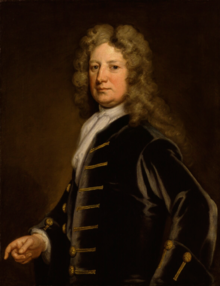Baron Wharton

Baron Whartonis a title in thePeerage of England,originally granted byletters patentto the heirs male of the1st Baron,which was forfeited in 1729 when the last male-line heir was declared an outlaw. The Barony was erroneously revived in 1916 bywrit of summons,thanks to an 1844 decision in the House of Lords based on absence of documentation. As such, the current Barony of Wharton could more accurately be listed as a new Barony, created in 1916, with the precedence of the older (and extinct) Barony.
The barony of 1544
[edit]
The titleBaron Whartonwas created in 1544 byletters patentforSir Thomas Wharton,who had previously served as aMember of ParliamentforCumberland,in recognition of his victory at theBattle of Solway Moss.Because of its creation by letters patent, the Barony could only be passed down to male heirs.
The5th Baron(1648–1715) had a long and distinguished political career, serving at various times as a Member of Parliament,Lord Lieutenantof Oxford andBuckingham,Lord Lieutenant of IrelandandLord Privy Seal.He was createdEarl of Wharton,in theCounty of Westmorland,andViscount Winchendon,ofWinchendonin theCounty of Buckingham,in 1706, in the Peerage of England, and in 1715 was further createdMarquess of Wharton,in the County of Westmorland, andMarquess of Malmesbury,in theCounty of Wilts,in thePeerage of Great Britain.Later that year, he was also createdMarquess of Catherlough,Earl of Rathfarnham,in theCounty of Dublin,andBaron Trim,in theCounty of Meath,in thePeerage of Ireland.(The Marquessate of Catherlough referred to the town now spelledCarlow.)
His son, the2nd Marquess(1698–1731), was createdDuke of Wharton,in the County of Westmorland, in the Peerage of Great Britain, in 1718, but all the titles were forfeit in 1729 when the Duke of Wharton was declared an outlaw. In any event, since on the Duke's death there were no male heirs of the 1st Baron remaining, all the titles would have become extinct at that point.
The Barony revived, or new Barony created
[edit]In 1844, however, the Barony was claimed by ColonelCharles Kemeys-Tynte,[1]and, since the document creating the peerage had been lost, theCommittee for Privilegesof theHouse of Lordsruled erroneously that the Barony was created bywritand could therefore be passed down through the female line.[2]As a consequence of their resolution, it was determined that at the death of the Duke of Wharton, the Barony had fallen intoabeyancebetween the Duke's sisters, LadyJane Holtand Lady Lucy Morice. It was further determined that, at Lady Lucy's death in 1739, Lady Jane (by now Lady Jane Coke) remained the sole heir, and had been therefore entitled to the Barony. Finally, it was determined that at her death the Barony again fell into abeyance, where it remained in the nineteenth century. The Committee for Privileges, however, also ruled that it did not have the authority to terminate the abeyance because of the existence of a judgement of outlawry against the Duke of Wharton. Thus the matter remained unresolved for 72 years.
On 15 February 1916, the abeyance was terminated by awrit of summonsfromKing George VtoParliamentin favour ofCharles Theodore Halswell Kemeys-Tynte,who became the 8th Baron.[3][4](He should be more properly listed as the 1st Baron Wharton, of the new barony.) At his death, the title was inherited successively by his son and thereafter by his daughter, Elisabeth, who became the 10th Baroness. At her death in 1974, the Barony again fell into abeyance, between her two daughters. It was once again revived in 1990, when the abeyance was terminated in favour of Myrtle Robertson. At her death, the Barony was inherited by her son Myles.
Barons Wharton (1544)
[edit]- Sir Thomas Wharton, 1st Baron Wharton(c. 1495–1568)
- Thomas Wharton, 2nd Baron Wharton(1520–1572)
- Philip Wharton, 3rd Baron Wharton(1555–1625)
- Philip Wharton, 4th Baron Wharton(1613–1696)
- Thomas Wharton, 5th Baron Wharton(1648–1715) (createdEarl of Whartonin 1706 andMarquess of Whartonin 1715)
Marquesses of Wharton (1715)
[edit]- Thomas Wharton, 1st Marquess of Wharton(1648–1715)
- Philip Wharton, 2nd Marquess of Wharton(1698–1731) (abeyant 1731) (createdDuke of Whartonin 1718)
Dukes of Wharton (1718)
[edit]- Philip Wharton, 1st Duke of Wharton(1698–1731) (forfeit 1729 (forfeiture retroactively reversed 1825), all except Barony extinct on his death, Barony abeyant on his death)
Barons Wharton (1544; continued)
[edit]- Jane Wharton, 7th Baroness Wharton(1706–1761) (became sole heir 1739; abeyant on her death)
- Charles Theodore Halswell Kemeys-Tynte, 8th Baron Wharton(1876–1934) (abeyance terminated 1916)
- Charles John Halswell Kemeys-Tynte, 9th Baron Wharton(1908–1969)
- Elisabeth Dorothy Kemeys-Tynte, 10th Baroness Wharton(1906–1974) (abeyant on her death)
- Myrtle Olive Felix Robertson, 11th Baroness Wharton(1934–2000) (abeyance terminated 1990)
- Myles Christopher David Robertson, 12th Baron Wharton (b. 1964)
Theheir presumptiveis the present holder's only child, the Hon. Meghan Ziky Mary Robertson (b. 2006).
Early Whartons
[edit]The Whartonbaronetcydates from 6 October 1292 whenKing Edward Igranted to Gilbert de Querton "the Manor of Querton with its appurtenances." ( "Querton" was the earlierLatinspelling of "Wharton" ) There de Querton builtLammersidefor himself and his wife, Emma de Hastings. (The remains of the building still stand and today resemble apele tower). Emma was the daughter of Nicholas de Hastings of the family which were the ancestors of the presentEarls of Huntingdonand ofPembroke.
The descendants of Sir Gilbert were:
- Sir Henry de Querton (c.1281–aft.1343)
- Sir Hugh de Querton (c.1308–bef.1389)
- Sir William de Wherton (c.1327–bef.1417)
- Sir John de Wharton (c.1360–1434)
- Sir Thomas de Wherton (c.1388–c.1440)
- Sir Henry Wharton (c.1437–?)
- Sir Thomas Wharton II (1460 or 1465–1531)
- Sir Thomas Wharton, 1st Baron Wharton(c. 1495–1568)
References
[edit]- Genealogical Research in England – The Origin of the Hastings— G. Andrews Moriarty, A.M., LL.B., F.S.A
- The Wharton Sleeve— Nathan Earl Wharton, 1949
Footnotes
[edit]- ^The Law Times, Volume 3, Page 1
- ^Round, John Horace(1901).Studies in peerage and family history.New York: Longmans Green & Co. p. 354.
- ^"Barony Of Wharton".Parliamentary Debates (Hansard).House of Lords. 14 December 1915. col. 591–592.
- ^"Kemeys and Kemeys-Tynte family, of Cefn Mabli, Monmouth".Dictionary of Welsh Biography.National Library of Wales.
External links
[edit]

